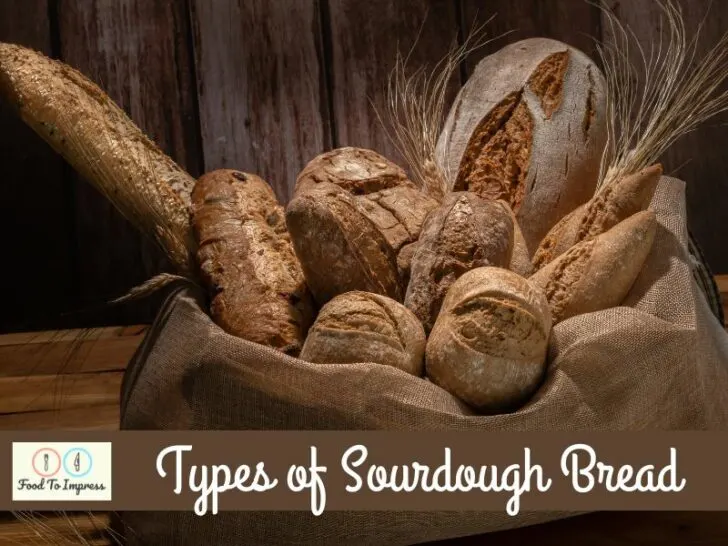Sourdough bread, with its tangy flavor and chewy crust, is a staple food for many and has gained immense popularity in recent years. The types of sourdough bread vary based on ingredients, techniques, and regional influences. This post will be your ultimate guide to understanding different types of sourdough bread and exploring the nuances in each variety.
There are several types of sourdough bread, each varying based on ingredients and regional influences. Common types include classic sourdough boules, whole wheat sourdough, rye sourdough bread, sourdough baguettes, and even sweet variations with ingredients like chocolate or fruit. Additionally, sourdough can be used as a base for other baked goods, such as pizzas and pastries.
The Magic Behind Sourdough: Wild Yeast and Lactic Acid Bacteria
Before diving into the various types of sourdough bread, it’s important to grasp the basics. Unlike breads leavened with commercial yeast, sourdough relies on wild yeast and lactic acid bacteria from the sourdough starter. This fermentation process not only gives sourdough its signature sour flavour but also offers various health benefits. The combination of wild yeast, acetic acid, and lactic acid bacteria ensures a unique taste and texture in each loaf of bread.
Types of Sourdough Bread: Ingredients and Techniques
Classic Sourdough
A classic sourdough, often known as a sourdough boule, is a round loaf with a thick crust and tangy crumb. Using simple ingredients like bread flour, water, and salt, its unique taste comes from the fermentation process of the sourdough starter. Bakers often slash the top of the dough with a razor blade to create beautiful patterns and allow for better oven spring.
For those interested in a variant, the Rosemary Sourdough Bread Recipe offers an aromatic twist to the classic by adding fresh rosemary for extra flavor.
Whole Wheat Sourdough Bread
By mixing bread flour with whole wheat flour, bakers can create a nutty flavor in their sourdough. Whole grains provide added nutrition, and the bread has a denser texture. Whole wheat sourdough bread is perfect for those looking for both taste and health benefits.
Rye Breads
There are different types of sourdough breads made primarily from rye flour. Rye breads tend to be denser and have a strong, earthy flavor. They can be mixed with white flour or other different flours to achieve various textures and flavors.
Sourdough Baguettes
Unlike the round sourdough boule, sourdough baguettes are long and slender, with a golden and chewy crust. They require a different shaping technique but use similar basic ingredients. Poppy seeds or sesame seeds can be sprinkled on top for added crunch.
Sweet Sourdough Breads
Not all sourdough has to be savory. By adding ingredients like chocolate chips, cream cheese, or pumpkin puree, sourdough can be transformed into a delightful sweet treat.
Sourdough Pizza
Yes, you read that right! Sourdough isn’t limited to just bread. The sourdough bread pizza recipe on Food to Impress takes your pizza game to a new level by using sourdough dough, which offers a chewy crust and a tangy undertone.
Tips for Perfect Sourdough Bread
Achieving the perfect loaf of sourdough bread requires patience and practice. Here are some key tips:
- Starter Health: A cup of starter that’s active, bubbly, and at room temperature is essential. Regular feeding keeps the sourdough starter healthy.
- Proofing: Using a proofing basket can help maintain the shape of the bread dough during its final rise.
- Baking: Many bakers swear by the dutch oven method for the best results, as it creates steam and helps in achieving a crispy crust.
- Bulk Fermentation: Let the dough rest and undergo bulk fermentation to develop flavor and structure.
- Shaping: Building surface tension while shaping ensures a good rise and oven spring. Wet hands or a bench knife can aid in the process.
Conclusion
Sourdough bread, with its myriad variations, offers something for everyone. Whether you’re a fan of classic sourdough, rye breads, or even sourdough pizza, there’s a type of sourdough bread out there for you. Plus, experimenting with different types of flour and additions can lead to your favorite sourdough bread recipe.
Want to dive deeper into the nuances of sourdough? Check out the comparison between artisan bread and sourdough or discover creative ways to use leftover sourdough bread.
Finally, remember, much like any skill, baking the perfect loaf of sourdough bread might require a few trials. But with patience, the right ingredients, and the joy of experimentation, happy baking awaits!

